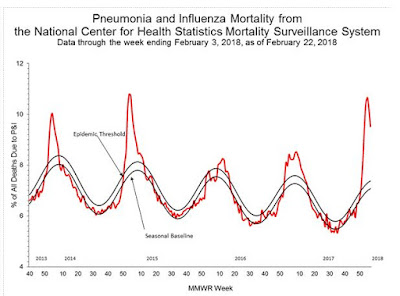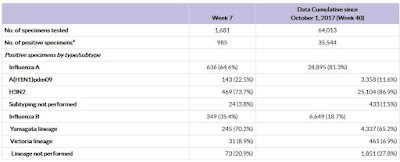 |
| Week 7 ILI Outpatient Visits Still Very High |
#13,169
While influenza activity appears to be backing off the record highs reported two weeks ago, the number of visits for ILI (influenza-like illness) remains very high (see chart above), and continues to exceed all of the peaks reported since the H1N1 pandemic of 2009.
Influenza related hospitalizations continue to soar, beating the end-of-season totals from the past 6 seasons handily (see mashup chart below), with several weeks of flu season to go.
The 2014-15 season was estimated to have seen around 700,000 hospitalizations, and while we have no totals yet, this year looks to exceed that number by a pretty good margin.
Worst affected have been those aged 65+ (322.7 per 100,000 population), followed by adults aged 50-64 (79.9 per 100,000 population) and children aged 0-4 years (52.6 per 100,000 population).P&I Mortality numbers have dropped a bit (see below), but there continue to be data collection delays, and the final numbers are apt to see adjustment upward.
The number of pediatric deaths (often a lagging indicator) jumped by another 13 cases, with several being delayed reports from earlier in the season.
While H3N2 continues to hold the lead, as the season progresses we continue to see both influenza B and H1N1 making gains.
We continue to see some states - particularly in the west - report a reduction in ILI activity (see map below), although most of the country remains in the grip of the grippe.
Some highlights from a much more detailed FluView include:
2017-2018 Influenza Season Week 7 ending February 17, 2018
All data are preliminary and may change as more reports are received.
Synopsis:
During week 7 (February 11-17, 2018), influenza activity remained elevated in the United States.
Viral Surveillance: The most frequently identified influenza virus subtype reported by public health laboratories during week 7 was influenza A(H3). The percentage of respiratory specimens testing positive for influenza in clinical laboratories remained elevated.As always, it isn't too late to get the flu shot. And with influenza B and H1N1 rising, it could still offer some valuable protection. But most of all, now is the time to practice good flu hygiene.
Pneumonia and Influenza Mortality: The proportion of deaths attributed to pneumonia and influenza (P&I) was above the system-specific epidemic threshold in the National Center for Health Statistics (NCHS) Mortality Surveillance System.
Influenza-associated Pediatric Deaths: Thirteen influenza-associated pediatric deaths were reported.
Influenza-associated Hospitalizations: A cumulative rate of 74.5 laboratory-confirmed influenza-associated hospitalizations per 100,000 population was reported.
Outpatient Illness Surveillance:The proportion of outpatient visits for influenza-like illness (ILI) was 6.4%, which is above the national baseline of 2.2%. All 10 regions reported ILI at or above region-specific baseline levels. New York City, the District of Columbia, Puerto Rico and 39 states experienced high ILI activity; five states experienced moderate ILI activity; three states experienced low ILI activity; and three states experienced minimal ILI activity.
Geographic Spread of Influenza:The geographic spread of influenza in Puerto Rico and 48 states was reported as widespread; the District of Columbia, Guam and two states reported local activity; and the U.S. Virgin Islands reported no activity.
Stay home if you are sick, avoid crowds, wash your hands frequently, and cover your coughs and sneezes.While we may have passed the peak of this flu season, there is undoubtedly a good deal of flu in store for the next few weeks, and the numbers will continue to come in for weeks after that.




